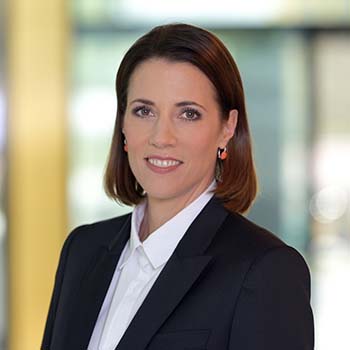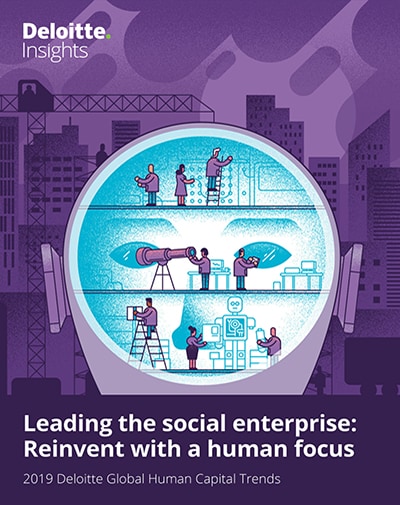
Leadership for the 21st century: The intersection of the traditional and the new 2019 Global Human Capital Trends
8 minute read
11 April 2019
Leaders today face new challenges due to the speed of technological, social, and economic change. Do these new challenges call for a new breed of leaders?
In a world of disruptive digital business models, augmented workforces, flattened organizations, and an ongoing shift to team-based work practices, organizations are challenging their leaders to step up and show the way forward. CEOs are being pressured to take a position on social issues; C-suite executives are being asked to work more collaboratively across functions; line leaders must learn to operate in networks of teams. But our research shows that while organizations expect new leadership capabilities, they are still largely promoting traditional models and mindsets—when they should be developing skills and measuring leadership in ways that help leaders effectively navigate greater ambiguity, take charge of rapid change, and engage with external and internal stakeholders.
Learn more
Watch the related video for this trend
View 2019 Global Human Capital Trends
Download the Deloitte Insights and Dow Jones app
Download the full report or create a custom PDF
Deloitte’s 10th annual Global Human Capital Trends Report is coming soon. Get it first by signing up!
Year after year, organizations tell us they struggle to find and develop future-ready leaders. In this year’s Global Human Capital Trends survey, 80 percent of respondents rated leadership a high priority for their organizations, but only 41 percent told us they think their organizations are ready or very ready to meet their leadership requirements.
We see leadership pipelines and development at a crossroads at which organizations must focus on both the traditional and the new. Organizations know that they must develop leaders for perennial leadership skills such as the ability to manage operations, supervise teams, make decisions, prioritize investments, and manage the bottom line. And they know that they must also develop leaders for the capabilities needed for the demands of the rapidly evolving, technology-driven business environment—capabilities such as leading through ambiguity, managing increasing complexity, being tech-savvy, managing changing customer and talent demographics, and handling national and cultural differences.
Leadership in a new context
It’s clear that many people believe that organizations have new leadership needs (figure 1). Eighty percent of the respondents to this year’s global survey told us they think that 21st-century leadership has unique and new requirements that are important or very important to their organization’s success. Topics such as inclusion, fairness, social responsibility, understanding the role of automation, and leading in a network were not part of the leadership manifesto a decade ago. And in the midst of these changes, many organizations are not satisfied with their leadership programs. Only 25 percent of our respondents say they are effectively building digital leaders, and only 30 percent say they are effectively developing leaders to meet evolving challenges.
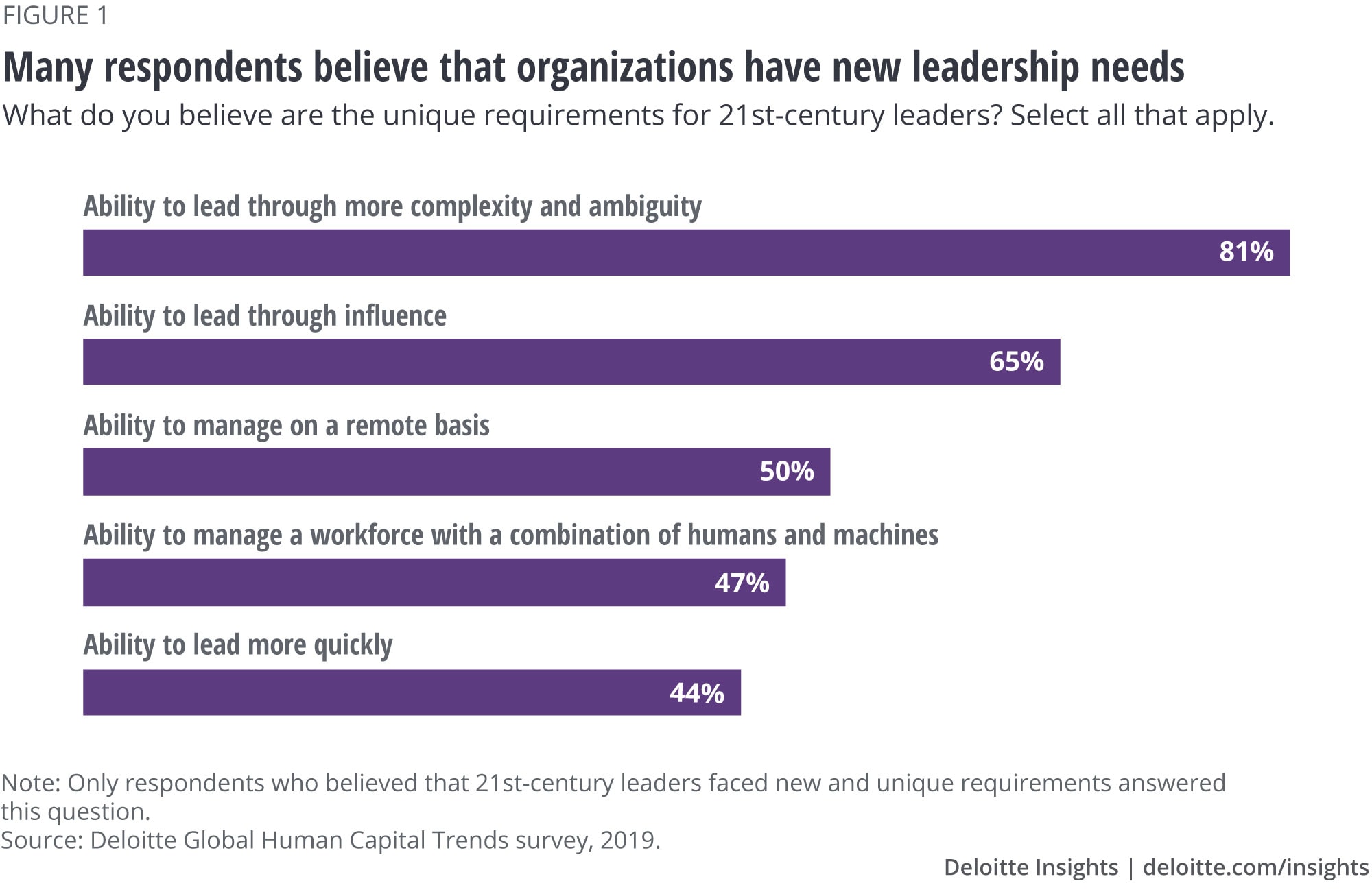
Yet even though many organizations have built digital leadership models, updated their frameworks, and invested in new leadership programs, we believe the greater need may lie in the combination of developing new competencies and putting them in a new context (figure 2). That new context is the changing set of social and organizational expectations for how leaders should act and what outcomes they should aim for. In the era of the social enterprise, people no longer believe that financial results are the only or primary measure on which a business’s success should be judged; they also judge organizations for the impact they have on the social and physical environment, as well as on their customers and the people who work for and with them. As a result, leaders that focus only on running a tight ship and competing relentlessly in the marketplace can be viewed as too narrow and not fully engaged with the challenges of the broader business and social environment.
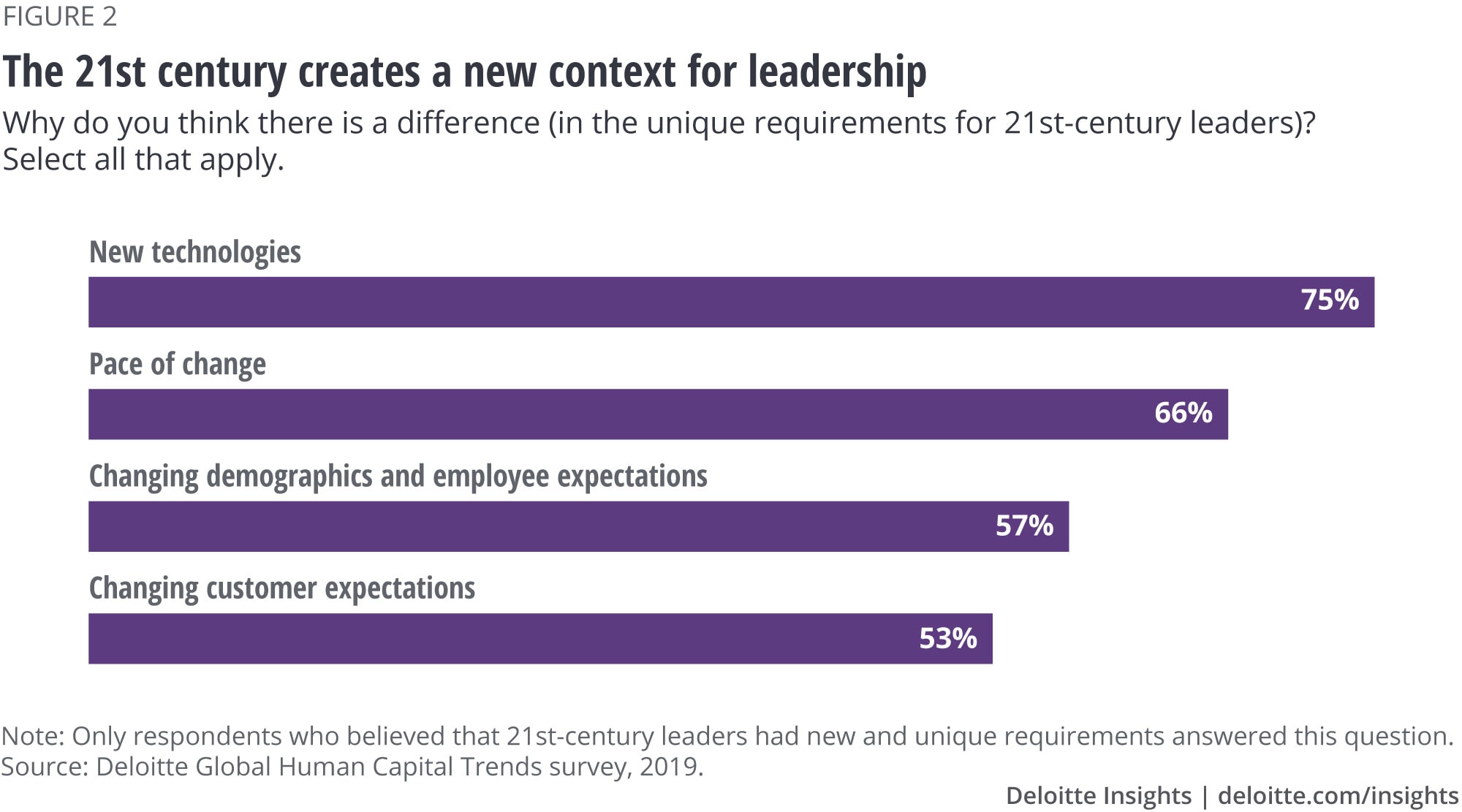
New competencies, new context
Traditional leadership expectations and outcomes still have a place in today’s new world of work, but they should be combined with a set of new competencies and recognition of a new context to round out how leadership is defined for the 21st century (figure 3).
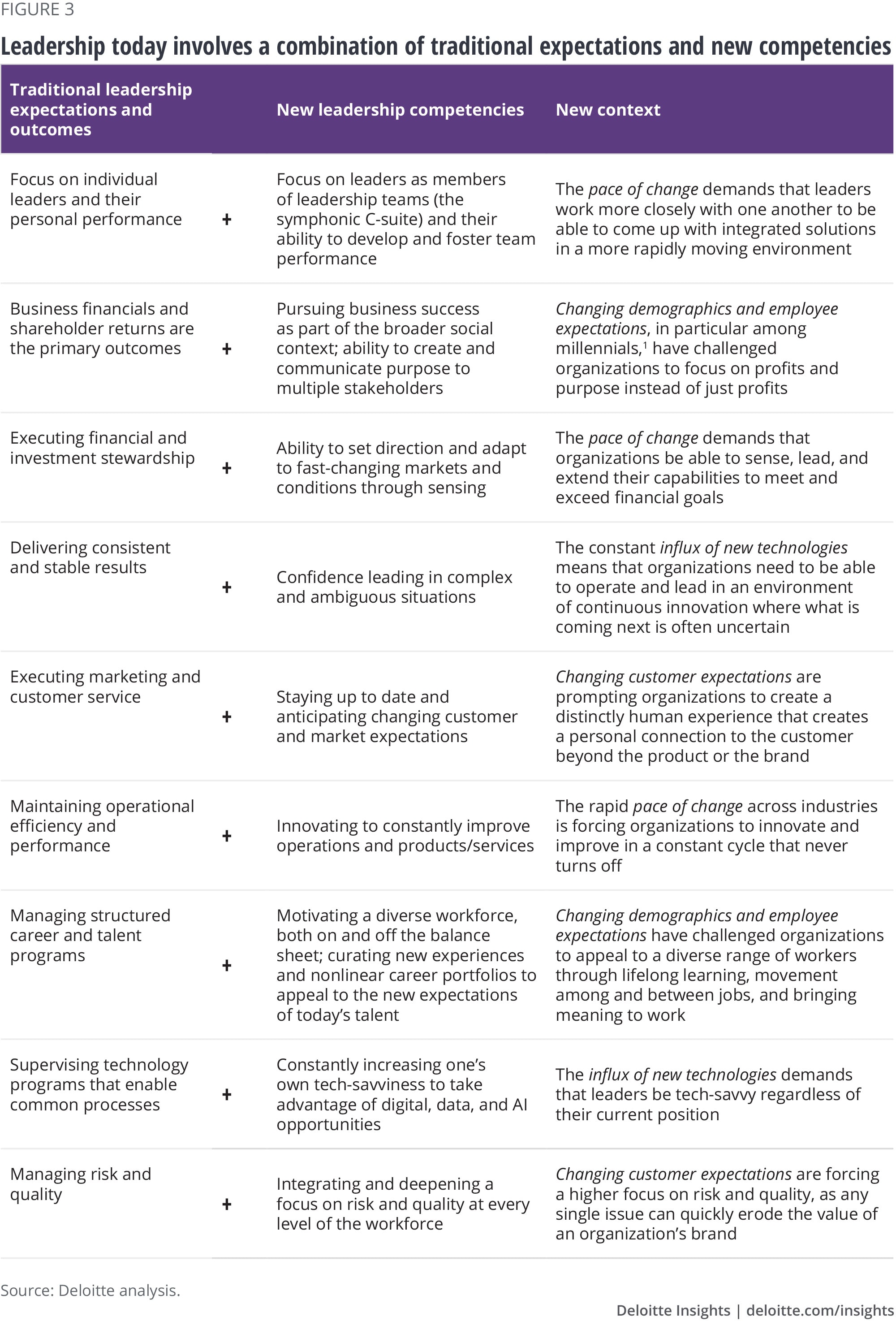
Where are the biggest gaps?
Developing leaders with new competencies requires more than an evolution in the competencies themselves. Equally paramount is for the organization to have the culture, the structure, and the management processes to cultivate these leaders. In our survey, we found three areas where significant gaps exist within many organizations.
Transparency. In today’s world of the social enterprise, transparency is the most valuable organizational currency. It helps engender trust and respect in a world where many may question an organization’s true intent. Yet as important as transparency is, only 18 percent of our survey respondents believed they have a transparent and open model; 37 percent were worried about their ability to create trust, 60 percent were worried about their employees’ perception of transparency, and 27 percent believed that a lack of transparency was creating a competitive disadvantage.
Internal collaboration. As organizations move into service-center business models, they’re able to benefit when C-suite leaders shift their focus beyond their narrow towers of responsibility and work more closely with one another. As we discussed in last year’s report, the C-suite’s roles and work are becoming much more complex and more integrated. Yet eighty-three percent of respondents told us their C-suite executives rarely collaborate or do so only on an ad hoc basis; only 17 percent said C-suite executives at their organization regularly collaborate.
Performance management. How individuals’ success is measured remains a powerful way to shape behavior. However, despite organizations’ strong desire to elicit different, more 21st-century behavior from their leaders, respondents described a very traditional approach to how they evaluate top leaders. The top three criteria organizations used to measure leadership success were driving strategy (63 percent), delivering financial results (58 percent), and managing operations well (44 percent).
Putting different performance measures in place for leaders can go a long way toward establishing a culture that supports competencies such as the ability to manage uncertainty and lead through change. Sasol, an integrated chemicals and energy company with operations in 32 countries, is one company that has made progress in establishing a culture of development through the way it measures its leaders. The company evaluates leaders based on employee engagement feedback, leadership capability assessments, and the ways in which leaders align themselves with the company’s leadership principles. These practices contribute to reinforcing a culture where leaders are encouraged to embrace change and recognize opportunities to innovate and pursue excellence.2
If organizations want leadership that is ready for the 21st century, they should first look at their own attributes to create the type of environment that will give rise to leaders’ success. Transparency, internal collaboration, and performance management are good places to start that process.
Refreshing leadership from within
Setting a new context, identifying new leadership competencies, and putting the right culture in place are all vital parts of an effective leadership strategy. The final step is to find and develop the individuals who will serve as the leaders themselves. But where can organizations find them?
Today, the idea that organizations can simply go out and “hire” new leaders is being called into question. Rather than searching to find and hire great leaders from the outside who may or may not succeed in the organization’s corporate culture, most organizations would do well to explore new approaches and to invest more in developing the potential leaders they have. In today’s fast-paced environment, people learn by doing—and trying. To cultivate needed leadership competencies, organizations can give people more diverse, developmental assignments; promote people into leadership roles both earlier and later in their careers; give leaders with less traditional experience the opportunity to run businesses and initiatives; and honor the ability of their workers and leaders at every level, from early to late in their careers, to rethink, challenge, and develop the business they’re in.
Many organizations continue to struggle to put leaders in place with the experience, capabilities, and motivation to take on both old and new business challenges. We suggest starting by taking a fresh look at the context in which leaders need to operate today, as it offers a key to cultivating the leaders of tomorrow.
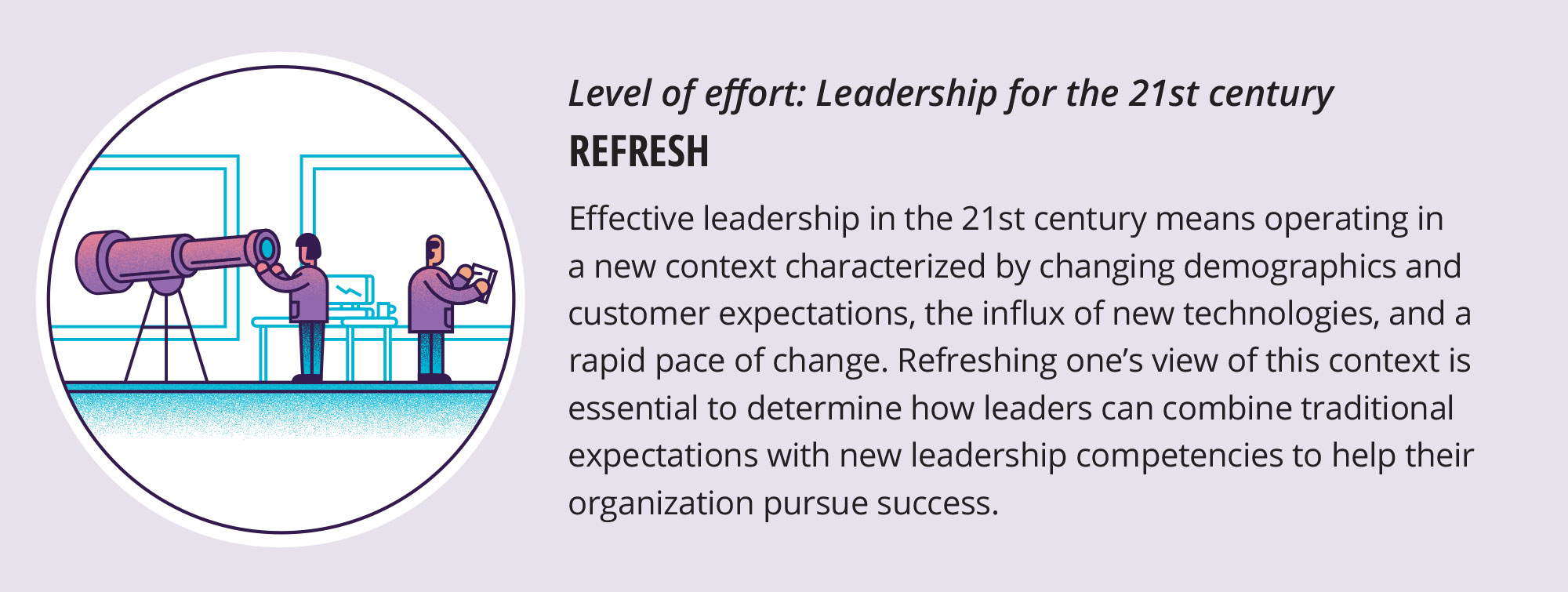
© 2021. See Terms of Use for more information.
Explore the collection
-
Accessing talent Article5 years ago
-
Talent mobility Article5 years ago
-
Rewards Article5 years ago
-
HR cloud Article5 years ago
-
Looking ahead Article5 years ago
-
2019 Global Human Capital Trends Collection

